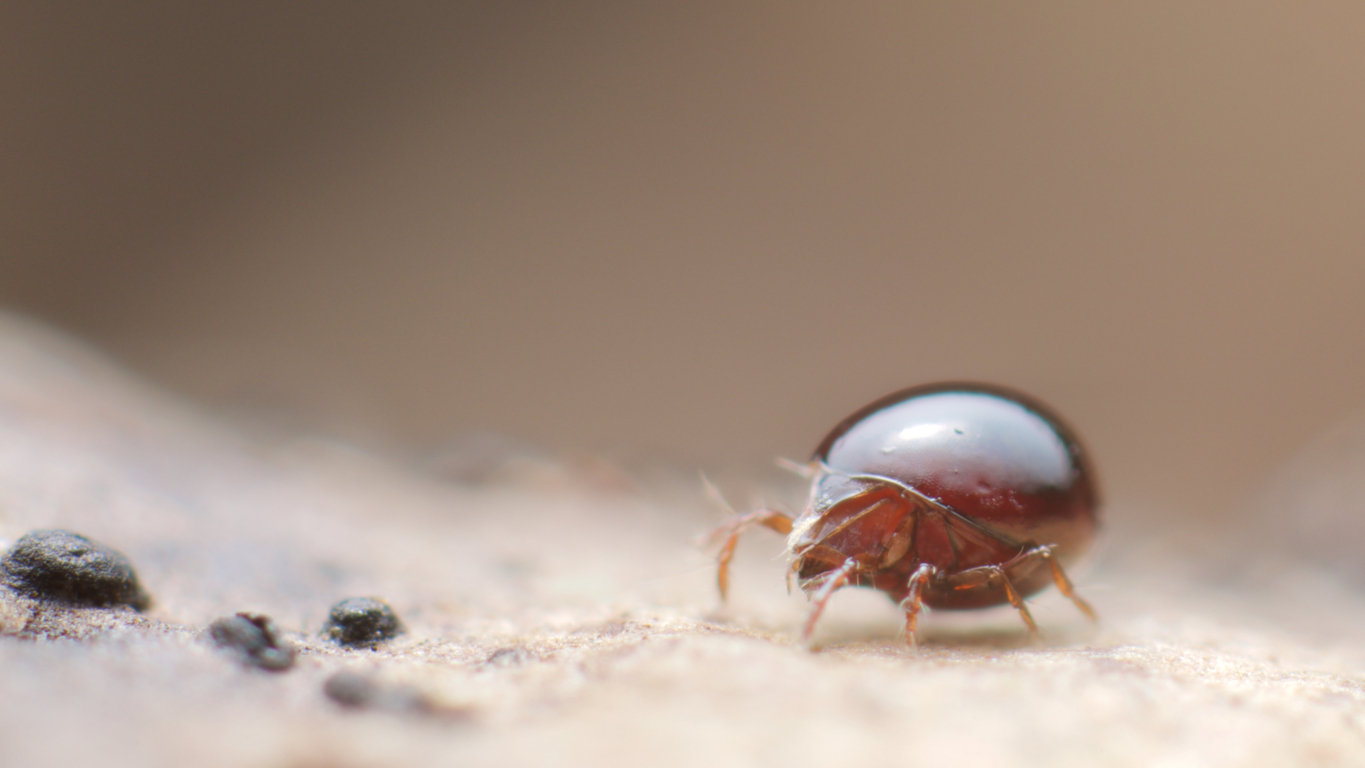
Acari
Acari or mites are one of the most abundant and diverse groups of soil microarthropods, with estimates up to 50,000-250,000 individuals per square meter of soil [1]and approximately 30,000 described species so far. Soil Acari occur everywhere, from the Arctic to Antarctica, and from the highest mountain top to the deepest caves. They are typically found in litter and soil layers of forests, meadows, and arable fields, but also in all other types of habitats, including in aboveground vegetation [2],[3]. Acari feed predominantly on litter, microbes, plant or other animals (dead or alive), playing a key role in primary production, pest control, litter decomposition and nutrient cycling [2],[3],[4],[5]. They are also an important food source for several (soil) invertebrate predators [2] and thereby take a central position in soil food webs [6].
Acari species and diversity are often used as bio-indicators responding to environmental and ecological factors, from soil chemistry and microclimatic conditions to land-use change and management intensity in forest and agroecosystems[7],[8]. Acari communities contribute to all of the soil function models, playing an important role in the soil food web.
Acari communities can be sampled by standardized techniques, involving specimen extraction by behavioural methods (e.g. Berlese-Tullgren funnels and the high-gradient MacFadyen apparatus)[9] or flotation[10]. Sorting and taxonomic identification are typically facilitated by available identification keys, but identification can be also achieved by newly developed molecular analyses tools, including DNA metabarcoding techniques[11] (cDNA and eDNA).
Acari species display a wide variation of eco-morphological traits indicating different life-forms related to vertical distribution in soils and feeding habits [12],[13],[14]. Acari are an insightful group to understand mechanisms underlying key soil processes and community responses to environmental conditions at local and landscape scales[7],[15]. Acari have already been included in soil quality indices (e.g. QBS) to assess soil quality and land-use sustainability[16].

Text by Prof. Dr. Matty P. Berg, Animal Ecology section of the Department of Ecological Science, Vrije Universiteit, Amsterdam, the Netherlands.
[1] Petersen H. 1982. Structure and size of soil animal populations. Oikos 39: 306-329.
[2] Walter DE & Proctor HC 1999. Mites: ecology, evolution and behaviour. CABI Publishing, Oxon, UK.
[3] Krantz GW & Walter DE 2009. A manual of Acarology. Texas Tech University Press, Lubbock, Texas, USA.
[4] Schneider K et al. 2004. Trophic niche differentiation in soil microarthropods (Oribatida, Acari): evidence from stable isotope ratios (15N/14N). Soil Biology and Biochemistry 36: 1769-1774.
[5] Koehler HH (1999). Predatory mites (Gamasina, Mesostigmata). Agriculture, Ecosystems & Environment 74: 395-410.
[6] Berg MP (2001). Community food web, decomposition and nitrogen mineralisation in a stratified Scots pine forest soil. Oikos 94: 130-142.
[7] Behan-Pelletier VM (1999). Oribatid mite biodiversity in agroecosystems: role for bioindication. Agriculture, ecosystems & environment 74: 411-423.
[8] Parisi V et al. 2005. Microarthropod communities as a tool to assess soil quality and biodiversity: a new approach in Italy. Agriculture, Ecosystem and Environment 105: 323–333.
[9] Crossley DA & Blair JM 1991. A high-efficiency, “low-technology” Tullgren-type extractor for soil microarthropods. Agriculture, Ecosystems & Environment 34: 187-192.
[10] Kuenen FJ et al. 2009. Extracting soil microarthropods with olive oil: A novel mechanical extraction method for mesofauna from sandy soils. European journal of soil biology 45: 496-500.
[11] Oliverio, AM et al. 2018. A DNA metabarcoding approach to characterize soil arthropod communities. Soil Biology and Biochemistry 125: 37-43.
[12] Pfingstl T 2013. Habitat use, feeding and reproductive traits of rocky-shore intertidal mites from Bermuda (Oribatida: Fortuyniidae and Selenoribatidae). Acarologia 53: 369-382.
[13] Minor MA et al. 2017. Taxonomic resolution and functional traits in the analysis of tropical oribatid mite assemblages. Experimental and Applied Acarology 73: 365-381.
[14] Vandewalle M. Et al. 2010. Functional traits as indicators of biodiversity response to land use changes across ecosystems and organisms. Biodiversity and Conservation 19: 2921–2947.
[15] Wickings K & Grandy AS 2011. The oribatid mite Scheloribates moestus (Acari: Oribatida) alters litter chemistry and nutrient cycling during decomposition. Soil Biology and Biochemistry 43: 351-358.
[16] Menta C et al. 2018. Soil Biological Quality index (QBS-ar): 15 years of application at global scale. Ecological Indicators 85: 773–780.
